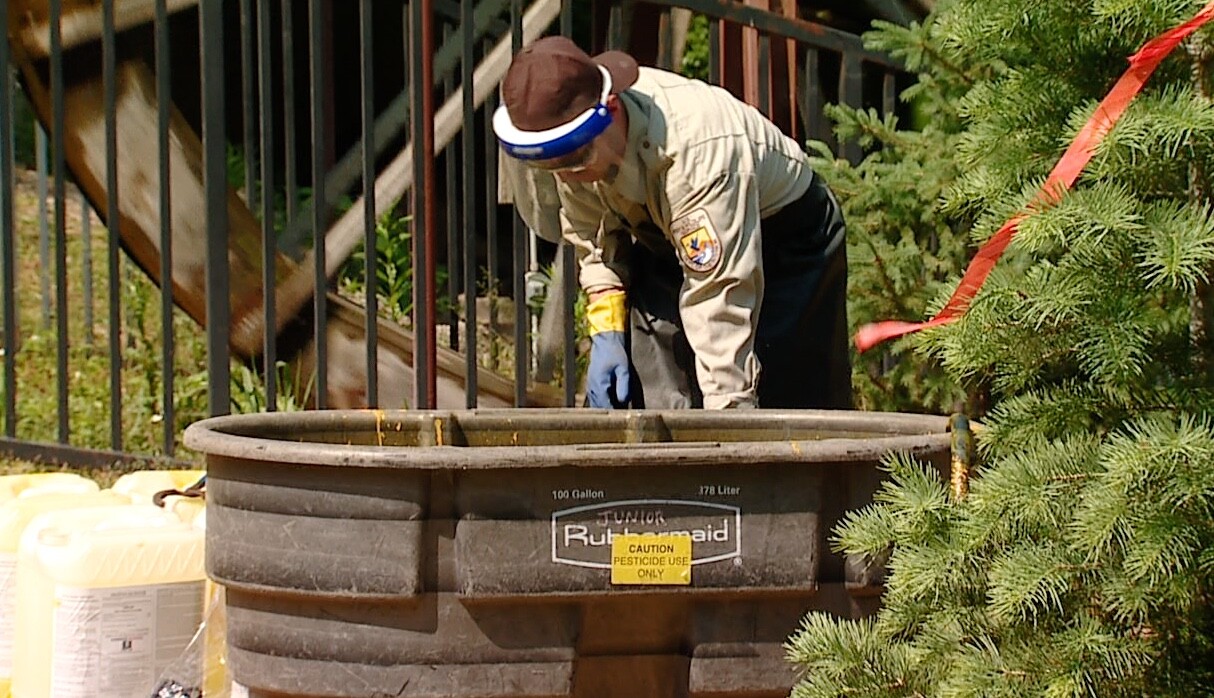GRAND RAPIDS, Mich. — Sea lamprey are an invasive species that have wreaked havoc on the Great Lakes for decades. While they originate from the Atlantic Ocean, they settled into the Great Lakes region during the 1930s via shipping canals.
Haleigh Vaughn spoke with Lauren Freitas, the Lampricide Treatment Supervisor with the U.S. Fish and Wildlife Service in Ludington, about the invasive species. She described them as the "vampires of the Great Lakes." With no predator in the Great Lakes, they were able to decimate the lake trout population.

Sea lamprey are known as a thirsty parasite with a large, round mouth with rows of razor-sharp teeth. They suck onto the side of sport fish with their suction cup mouth, which latches on and drills a hole into the side of the sport fish's side. The sea lamprey then sucks their blood, juices, and fluids. According to Freitas, one adult sea lamprey can kill 40 pounds of sport fish within a 12 to 18 month period.
With this obvious problem, the U.S. Fish and Wildlife service quickly stepped in during the 1950s to help protect our Great Lakes. Prior to the control efforts by the U.S. Fish and Wildlife service, Lake Michigan had over 600,000 sea lamprey adults, according the Freitas. The three year average is currently down to 61,000.

U.S. Fish and Wildlife Service personnel will apply lampricides to the Rogue River and Crockery Creek in Kent and Ottawa Counties to kill sea lamprey larvae burrowed in the stream bottom this weekend. According to the Great Lakes Fishery Commission to the U.S. Fish and Wildlife Service and Department of Fisheries and Oceans Canada, "Sea lamprey larvae live in certain Great Lakes tributaries and transform to parasitic adults that migrate to the Great Lakes and kill fish. Failure to kill the larvae in streams would result in significant damage to the Great Lakes fishery. Infested tributaries must be treated every three to five years with lampricides to control sea lamprey populations."

Aside from viewing the U.S. Fish and Wildlife Service members along the riverside and the slight change in color of the river, everything in West Michigan is "business as usual." The lampricides have little to no impact on members of the community. People and pets are still able to swim, domestic livestock can drink the water, and you can even eat the fish you catch. The U. S. Environmental Protection Agency and Health Canada Pest Management Regulatory Agency have reviewed human health and environmental safety data for lampricides, and in 2003 concluded that the lampricides (Lampricid and Bayluscide) pose no unreasonable risk to the general population and the environment when applied at concentrations necessary to control larval sea lampreys.

However, as with any pesticide, the public is advised to use discretion and minimize unnecessary exposure. According to the Great Lakes Fishery Commission to the U.S. Fish and Wildlife Service and Department of Fisheries and Oceans Canada, "Lampricides are selectively toxic to sea lampreys, but a few fish, insect, and broadleaf plants are sensitive. Persons confining bait fish or other organisms in stream water are advised to use an alternate water source because lampricides may cause mortality among aquatic organisms stressed by crowding and handling. Agricultural irrigation must be suspended for 24 hours, during and following treatment."
Prior to treatment, members of the U.S. Fish and Wildlife Service collect data on stream water chemistry. They may conduct on-site toxicity tests with lampricides and stream flow studies with dyes that cause stream water to appear red or green. Freitas shared that this often a vegetable-based dye.

The U.S. Fish and Wildlife Service then carefully monitor the river, making sure that the lampricides are maintained and carried downstream.
For additional information about the process, you can call 1-800-472-9212. TTY users may reach the Marquette or Ludington Biological Stations through the Michigan State Relay Service at 1-800-649-3777.
There are things that you can do to help invasive species from entering our Great Lakes, rivers, and streams. “Awareness and education are the key. Invasive species are one of the biggest threats to the Great Lakes, and infestations can even start in our own backyards," said Freitas. "From the ornamental or non-native plants that we're planting in our gardens, to even the boats. If we're failing to wash them, or drain the water out of them, before taking them from one right one river to the next. All of these little things start literally in our backyard, in our homes.”
The impacts of invasive species goes beyond the fisherman, to every person who simply wants to enjoy the Great Lakes.
For more information about invasive species, sea lamprey, and how you can protect our Great Lakes Region, visit GLFC.org.





